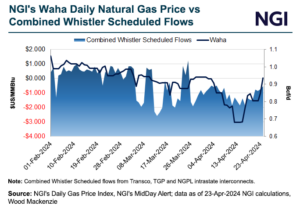Weekly Natural Gas Prices Struggle to Find Momentum
Spot prices stumbled during the past week, with demand easing in Texas and markets in the West as temperatures moderated from the prior week amid bouts of rain and a slightly cooler weather pattern nationally.

NGI’s Weekly Spot Gas National Avg. lost 6.5 cents to $1.620 for the July 20-24 period.
Increased spread of the coronavirus during the week may also have functioned as an anchor of sorts on prices in areas such as California and across much of the southern United States, where the pandemic is intensifying and threatening new restrictions on business activity, a development that could hamper commercial and industrial energy needs. Cases in the United States topped 4 million during the week.
As the trading week culminated, price declines were found across much of the Lower 48.
El Paso Permian shed 21.5 cents to $1.320, while Kern Delivery dipped 19.5 cents to $1.650, and SoCal Citygate lost 21.5 cents to $1.780.
Looking ahead to the final week of July, NatGasWeather sees continued summer heat but some pullback in temperatures in parts of the country.
“Hot high pressure will strengthen … to rule much of the country with widespread highs of 90s for very strong demand, including the important East regions where highs will reach the mid-90s, including in New York City and Washington D.C.,” the forecaster said.
“However, cooler trending weather systems remain on track to race across the Great Lakes and interior Northeast,” with highs in the 70s and 80s. Additionally, “weak cool shots are expected to continue across the northern United States into mid-August, while very warm to hot elsewhere.”
Futures Fire Up
August natural gas futures started the week sluggishly but found some momentum Tuesday and Wednesday ahead of the U.S. Energy Information Administration’s (EIA) storage report, as forecasts called for a light build that would signal a decreasing probability of U.S. gas exceeding storage capacity.
When the EIA on Thursday reported an injection into gas stocks of 37 Bcf for the week ending July 17, it marked the lightest build in a four-week string of double-digit injections and was generally in line with the averages of major polls. The result infused confidence into markets that, while easing recently, robust summer heat overall across the Lower 48 is generating cooling demand strong enough to ward off containment problems.
“A tighter market is likely by the time summer heat begins to ease,” NatGasWeather said.
Importantly, cooling demand and strong levels of power burns further open the window of time for economic recovery and improvement in demand for U.S. liquefied natural gas (LNG) exports. The pandemic-induced economic downturn suppressed LNG demand from key export destinations in Europe and Asia. In recent years, prior to the onset of the coronavirus, U.S. LNG exports played a vital role in supporting gas prices.
Already, there are early signs that LNG is stabilizing. A Bloomberg survey found that traders expect no more than 30 LNG cargoes to be cancelled for September, down from around 40 for August and an estimated 50 for July.
Domestic production, too, remains modest. Associated natural gas production out of the Permian Basin rebounded in June and early July as oil drillers resumed activity. But daily gas production volumes in the Permian have since slipped, RBN Energy LLC analyst Sheetal Nasta said in a report, and rig counts remain exceptionally low relative to a year ago, keeping further production increases at bay for now.
Baker Hughes Co. (BKR) said declines in natural gas-directed drilling dropped the overall U.S. rig count two units to 251 for the week ending July 24. The United States added one oil-directed rig for the week, the first net increase in BKR’s oil count since mid-March. The modest uptick in oil drilling partially offset a three-rig decline in domestic natural gas rigs. That left the combined U.S. count nearly 700 rigs behind the 946 active units a year ago.
“The meager drilling and completion activity suggests that the natural declines of existing wells, which were temporarily exaggerated by the shut-ins, will now be felt — and felt for as long as rig counts remain depressed, not just in the Permian but also in other oil-focused basins,” Nasta said.
Against that broad backdrop, the August Nymex contract on Friday rose 2.3 cents day/day and settled at $1.808/MMBtu. That followed a double-digit increase the prior day.
Cash Finishes Strong
Spot prices advanced the final day of the week as signs of demand strength developed.
The Northeast region led the upward charge. PNGTS surged 31.5 cents day/day to average $2.975, while Algonquin Citygate gained 21.0 cents to $1.775.
Elsewhere, Opal climbed 8.5 cents to $1.570, and Columbia Gas rose 6.0 cents to $1.535.
The West Texas region, where rain and some easing in extreme heat lightened demand, was an exception. Waha lost 20.5 cents to $1.080.
The National Hurricane Center (NHC) on Friday was monitoring Tropical Storm (TS) Hanna, east of Corpus Christi in South Texas. The storm was expected to track through the Gulf of Mexico before making landfall by Saturday as a hurricane with heavy rains and strong winds.
“Minor production disruptions are possible but less than demand losses,” NatGasWeather said.
Asked about the potential for disruption to LNG activity at the export facility in Corpus Christi, a Cheniere Energy Inc. spokesperson said Friday “no operational impacts are expected at this time.”
Farther out in the Atlantic, TS Gonzalo was threatening the southern Windward Islands as it charted a westward course. The NHC said Gonzalo could strengthen into a hurricane on Saturday as it passed the Venezuelan coast, but it was expected to weaken again into a tropical storm as it moved into the eastern Caribbean Sea by Sunday.
“Models indicate more development is possible in the Atlantic” over the coming week as well, Bespoke Weather Services said. “Storm activity will be another wildcard to consider as an influence on temperatures.”
© 2024 Natural Gas Intelligence. All rights reserved.
ISSN © 1532-1258 |


